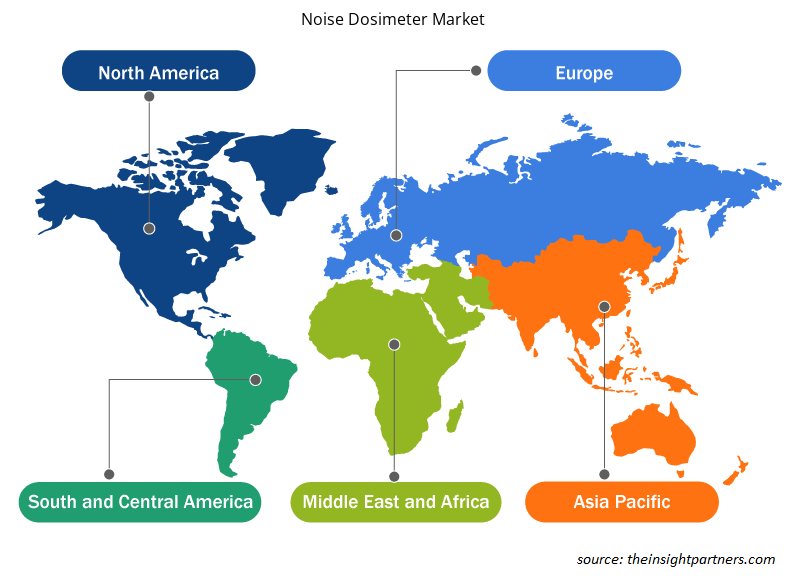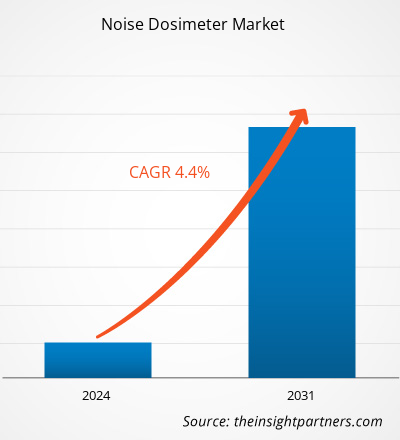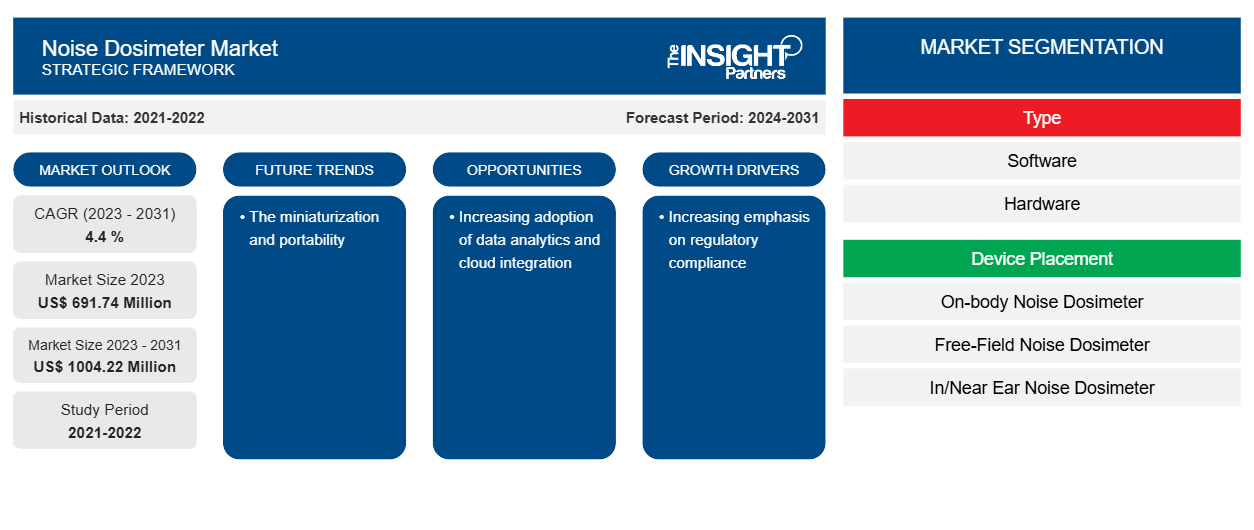Der Markt für Lärmdosimeter soll von 691,74 Millionen US-Dollar im Jahr 2023 auf 1.004,22 Millionen US-Dollar im Jahr 2031 anwachsen. Der Markt wird im Zeitraum 2023–2031 voraussichtlich eine durchschnittliche jährliche Wachstumsrate von 4,4 % verzeichnen. Miniaturisierung und Portabilität dürften weiterhin ein wichtiger Trend auf dem Markt bleiben.
Lärmdosimeter Marktanalyse
Die Nachfrage auf diesem Markt wird auf die zunehmende Verwendung von persönlichen Lärmdosimetern zurückgeführt. Für Gesundheits- und Sicherheitsexperten sowie Arbeitshygieniker sind Lärmschutzmaßnahmen am Arbeitsplatz heute unverzichtbar. In vielen Produktionsstätten in der industrialisierten Welt herrscht immer noch ein hoher Lärmpegel. In verschiedenen Regionen wird die Lärmdosis eines Arbeiters lieber mit einem persönlichen Gerät überprüft. Gleichzeitig verwenden andere Länder eine Kombination aus tragbaren Lärmpegelmessern und einer geringeren Anzahl persönlicher Lärmdosimeter. Für eine vielbeschäftigte Person, die im Büro möglicherweise mit zahlreichen zusätzlichen Risiken zu kämpfen hat, sind die Vorteile eines persönlichen Lärmdosimeters viele Systeme, die derzeit mit neuen Systemen verwendet werden.
Lärmdosimeter Marktübersicht
Es gibt keine einheitliche Methode oder Verfahren zur Messung von Berufslärm. Fachleute für Gehörschutz und -gesundheit können verschiedene Instrumente zur Lärmmessung verwenden und aus mehreren Instrumenten und Software zur Überprüfung ihrer Messungen wählen. Die Wahl eines bestimmten Instruments und Ansatzes zur Analyse und Messung von Berufslärm hängt von verschiedenen Faktoren ab, nicht zuletzt vom Grund der Messung und der Umgebung, in der die Messung durchgeführt wird. Der Vorgang der Lärmmessung mit einem Schallpegelmesser ist relativ unkompliziert, wenn der Lärmpegel konstant ist und der Arbeiter während der Arbeitsschicht im Wesentlichen stationär bleibt. Ein Lärmdosimeter wird zur Messung der Lärmbelastung eines Arbeiters empfohlen, wenn der Lärmpegel variiert oder intermittiert.
Passen Sie diesen Bericht Ihren Anforderungen an
Sie erhalten kostenlose Anpassungen an jedem Bericht, einschließlich Teilen dieses Berichts oder einer Analyse auf Länderebene, eines Excel-Datenpakets sowie tolle Angebote und Rabatte für Start-ups und Universitäten.
- Holen Sie sich die wichtigsten Markttrends aus diesem Bericht.Dieses KOSTENLOSE Beispiel umfasst eine Datenanalyse von Markttrends bis hin zu Schätzungen und Prognosen.
Treiber und Chancen auf dem Lärmdosimetermarkt
Zunehmende Betonung der Einhaltung gesetzlicher Vorschriften
Das Mehrkanal-Lärmdosimeter ermöglicht die gleichzeitige Messung aller Parameter, die zur Beurteilung der Lärmbelastung von Arbeitnehmern und zur Auswahl des Gehörschutzes mithilfe von SNR, HML oder Oktavbändern erforderlich sind. Jeder Kanal kann individuell konfiguriert werden, um alle Lärmmessstandards, Vorschriften oder Richtlinien zu erfüllen. Dadurch kann das Dosimeter eine breite Palette von Daten messen und die Informationen bereitstellen, die zur Einhaltung aller Lärmstandards am Arbeitsplatz erforderlich sind. Mit zunehmender Betonung der Einhaltung gesetzlicher Vorschriften steigt daher die Nachfrage nach Lärmdosimetern.
Zunehmende Nutzung von Datenanalyse und Cloud-Integration
Die nächste große Revolution in der Lärmmessung wird wahrscheinlich die Art und Weise verändern, wie Lärm gemessen und überwacht wird. Die Integration der Cloud-Technologie in die Lärmmessung ist ein Wendepunkt für die Branche, der verspricht, die Art und Weise zu verbessern, wie Organisationen auf der ganzen Welt ihre Mitarbeiter und die Umwelt vor den Risiken extremer Lärmbelastung schützen. Mit der Cloud verbundene Lärmbeobachter können an verschiedenen Standorten an einem oder an mehreren Standorten installiert werden und so ein möglichst großes geografisches Gebiet abdecken. Die Cloud-Technologie überwindet die Herausforderungen, die bei Betrieben an mehreren Standorten auftreten, und verspricht, die Lärmüberwachung effizienter und zugänglicher zu machen als herkömmliche Methoden. Die zunehmende Einführung von Datenanalysen und Cloud-Integration schafft also mehr Möglichkeiten für den Markt.
Segmentierungsanalyse des Marktberichts für Lärmdosimeter
Wichtige Segmente, die zur Ableitung der Marktanalyse für Lärmdosimeter beigetragen haben, sind Typ, Geräteplatzierung und Anwendung.
- Basierend auf dem Typ ist der Markt für Lärmdosimeter in Hardware und Software unterteilt. Das Softwaresegment hatte im Jahr 2023 einen größeren Marktanteil.
- Nach Geräteplatzierung ist der Markt in am Körper getragene Lärmdosimeter, Freifeld-Lärmdosimeter und Im-/Nah-Ohr-Lärmdosimeter segmentiert.
- Nach Anwendung ist der Markt in die Branchen Luft- und Raumfahrt und Verteidigung, Automobil, Bauwesen sowie Fabriken und Unternehmen segmentiert.
Lärmdosimeter Marktanteilsanalyse nach Geografie
Der geografische Umfang des Marktberichts zum Lärmdosimeter ist hauptsächlich in fünf Regionen unterteilt: Nordamerika, Asien-Pazifik, Europa, Naher Osten und Afrika sowie Süd- und Mittelamerika.
Der APAC-Raum dominiert den Markt für Lärmdosimeter. Die Schätzung von Industrielärm unterscheidet sich erheblich von der von Verkehrslärm. Im Gegensatz zum Verkehrslärm, der mithilfe einer Sammlung von Eingabedatensätzen hochgerechnet werden kann, gibt es für Industrielärm keine ähnlichen Ansätze. Die einzige Möglichkeit, die Emission einer Industriequelle zu bestimmen, besteht darin, sie zu ermitteln. Der Anstieg der industriellen Lärmemissionen und der dringende Bedarf, diese zu kontrollieren, führen in mehreren Branchen im APAC-Raum zur Einführung von Lärmdosimetern.
Regionale Einblicke in den Lärmdosimetermarkt
Die regionalen Trends und Faktoren, die den Markt für Lärmdosimeter im Prognosezeitraum beeinflussen, wurden von den Analysten von Insight Partners ausführlich erläutert. In diesem Abschnitt werden auch die Marktsegmente und die Geografie für Lärmdosimeter in Nordamerika, Europa, im asiatisch-pazifischen Raum, im Nahen Osten und Afrika sowie in Süd- und Mittelamerika erörtert.

- Holen Sie sich die regionalspezifischen Daten für den Lärmdosimetermarkt
Umfang des Marktberichts zu Lärmdosimetern
| Berichtsattribut | Details |
|---|---|
| Marktgröße im Jahr 2023 | 691,74 Millionen US-Dollar |
| Marktgröße bis 2031 | 1004,22 Millionen US-Dollar |
| Globale CAGR (2023 - 2031) | 4,4 % |
| Historische Daten | 2021-2022 |
| Prognosezeitraum | 2024–2031 |
| Abgedeckte Segmente | Nach Typ
|
| Abgedeckte Regionen und Länder | Nordamerika
|
| Marktführer und wichtige Unternehmensprofile |
|
Dichte der Marktteilnehmer für Lärmdosimeter: Die Auswirkungen auf die Geschäftsdynamik verstehen
Der Markt für Lärmdosimeter wächst rasant, angetrieben durch die steigende Nachfrage der Endnutzer aufgrund von Faktoren wie sich entwickelnden Verbraucherpräferenzen, technologischen Fortschritten und einem größeren Bewusstsein für die Vorteile des Produkts. Mit steigender Nachfrage erweitern Unternehmen ihr Angebot, entwickeln Innovationen, um die Bedürfnisse der Verbraucher zu erfüllen, und nutzen neue Trends, was das Marktwachstum weiter ankurbelt.
Die Marktteilnehmerdichte bezieht sich auf die Verteilung der Firmen oder Unternehmen, die in einem bestimmten Markt oder einer bestimmten Branche tätig sind. Sie gibt an, wie viele Wettbewerber (Marktteilnehmer) in einem bestimmten Marktraum im Verhältnis zu seiner Größe oder seinem gesamten Marktwert präsent sind.
Die wichtigsten auf dem Markt für Lärmdosimeter tätigen Unternehmen sind:
- Bruel & Kjaer
- Casella (IDEAL INDUSTRIES, INC.)
- CESVA INSTRUMENTS SLU
- 3M
- SVANTEK
- Cirrus Research plc
Haftungsausschluss : Die oben aufgeführten Unternehmen sind nicht in einer bestimmten Reihenfolge aufgeführt.

- Überblick über die wichtigsten Akteure auf dem Markt für Lärmdosimeter
Neuigkeiten und aktuelle Entwicklungen zum Lärmdosimeter-Markt
Der Markt für Lärmdosimeter wird durch die Erhebung qualitativer und quantitativer Daten nach Primär- und Sekundärforschung bewertet, die wichtige Unternehmensveröffentlichungen, Verbandsdaten und Datenbanken umfasst. Nachfolgend sind einige der Entwicklungen auf dem Markt für Lärmdosimeter aufgeführt:
- Mit der Einführung des brandneuen persönlichen Lärmdosimeters Quest™ Edge 7 hat TSI die neuesten Entwicklungen in der Lärmdosimetrie vorgestellt. In lauten Arbeitsumgebungen ist der Schutz des Gehörs der Arbeitnehmer von entscheidender Bedeutung für ihre Sicherheit und Gesundheit. Das persönliche Lärmdosimeter TSI® Quest™ Edge ist ein leistungsstarkes und intuitives Instrument zur Erkennung von Hörverlustgefahren und zur Gestaltung von Gehörschutzprogrammen und technischen Maßnahmen. (Quelle: TSI, Pressemitteilung, Juli 2023.)
- Wir stellen das NEUE persönliche Lärmdosimeter SKC NoiseCHEK vor. Übermäßige Belastung durch hohe Lärmpegel am Arbeitsplatz kann bei Arbeitnehmern zu Hörverlust und anderen Gesundheitsproblemen führen und wird daher durch die von Safe Work Australia festgelegten Lärmgrenzwerte geregelt. Die Verwendung der entsprechenden Sicherheitsausrüstung, um sicherzustellen, dass die Lärmbelastung den 8-Stunden-Durchschnitt von 85 Dezibel oder den Spitzenwert von 140 Dezibel nie überschreitet, ist für die Sicherheit Ihres Teams von entscheidender Bedeutung. (Quelle: SKC NoiseCHEK, Pressemitteilung, September 2023)
Marktbericht zu Lärmdosimetern – Abdeckung und Ergebnisse
Der Bericht „Marktgröße und Prognose für Lärmdosimeter (2021–2031)“ bietet eine detaillierte Analyse des Marktes, die die folgenden Bereiche abdeckt:
- Marktgröße und Prognose für Lärmdosimeter auf globaler, regionaler und Länderebene für alle wichtigen Marktsegmente, die im Rahmen des Berichts abgedeckt sind
- Markttrends für Lärmdosimeter sowie Marktdynamik wie Treiber, Einschränkungen und wichtige Chancen
- Detaillierte PEST/Porters Five Forces- und SWOT-Analyse
- Marktanalyse für Lärmdosimeter mit wichtigen Markttrends, globalen und regionalen Rahmenbedingungen, wichtigen Akteuren, Vorschriften und aktuellen Marktentwicklungen
- Branchenlandschaft und Wettbewerbsanalyse, einschließlich Marktkonzentration, Heatmap-Analyse, prominenten Akteuren und aktuellen Entwicklungen auf dem Markt für Lärmdosimeter
- Detaillierte Firmenprofile
- Historische Analyse (2 Jahre), Basisjahr, Prognose (7 Jahre) mit CAGR
- PEST- und SWOT-Analyse
- Marktgröße Wert/Volumen – Global, Regional, Land
- Branchen- und Wettbewerbslandschaft
- Excel-Datensatz
Aktuelle Berichte
Erfahrungsberichte
Grund zum Kauf
- Fundierte Entscheidungsfindung
- Marktdynamik verstehen
- Wettbewerbsanalyse
- Kundeneinblicke
- Marktprognosen
- Risikominimierung
- Strategische Planung
- Investitionsbegründung
- Identifizierung neuer Märkte
- Verbesserung von Marketingstrategien
- Steigerung der Betriebseffizienz
- Anpassung an regulatorische Trends





















 Kostenlose Probe anfordern für - Markt für Lärmdosimeter
Kostenlose Probe anfordern für - Markt für Lärmdosimeter